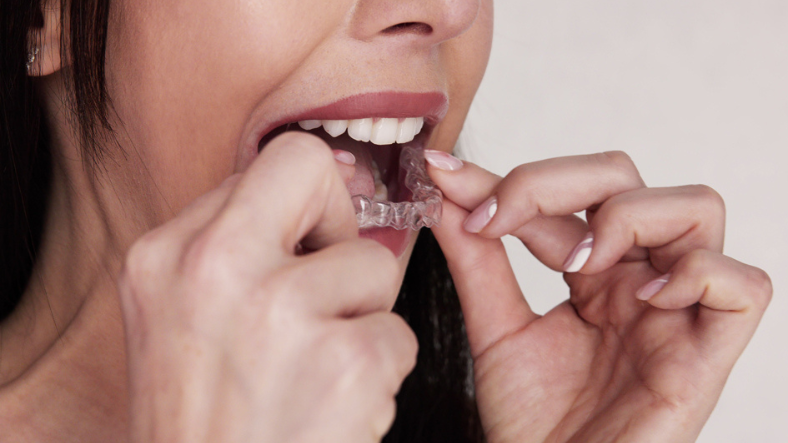Invisalign has revolutionized orthodontic treatment, offering a discreet and comfortable alternative to traditional metal braces. These clear aligners are custom-made for each patient and gradually shift teeth into their ideal positions. But how exactly does this process work?
The secret lies in advanced orthodontic biomechanics, controlled force application, and bone remodeling. Unlike braces, which use metal brackets and wires, Invisalign relies on a series of clear plastic trays designed to guide tooth movement over time. In this article, we will explore the science behind Invisalign and how clear aligners effectively shift teeth to create a straighter smile.
How Invisalign Works: A Step-by-Step Process
-
Digital Scanning and Treatment Planning
The Invisalign journey begins with a comprehensive digital scan of the patient’s teeth. Traditional orthodontic treatments often require physical impressions, but Invisalign uses 3D scanning technology, such as the iTero scanner, to create a precise digital model of the patient’s teeth.
Once scanned, the images are processed using advanced software to generate a virtual treatment plan. Orthodontists use this model to map out the step-by-step movement of each tooth, ensuring a predictable and efficient alignment process.
Additionally, artificial intelligence (AI) plays a role in optimizing treatment plans by analyzing past cases and determining the best approach for each patient.
-
Custom Aligners and Gradual Adjustments
After the digital treatment plan is finalized, Invisalign aligners are custom-manufactured using SmartTrack® material, a patented, flexible plastic designed to provide gentle but consistent force on the teeth.
Each set of aligners is slightly different, moving the teeth in small increments. Typically, patients switch to a new set every 1-2 weeks, with each tray shifting the teeth by approximately 0.25mm. Over time, these micro-movements lead to significant realignment without causing excessive discomfort.
-
Biomechanics of Clear Aligners
Invisalign works by applying controlled force to specific teeth, guiding them into new positions gradually. The biomechanics of clear aligners are different from traditional braces in the following ways:
- Uniform Pressure vs. Point Force: Traditional braces use brackets and wires to pull teeth, applying force at specific points. Invisalign, on the other hand, distributes pressure evenly across the tooth surface.
- Sequential Movement: Instead of moving all teeth at once, aligners focus on shifting a few teeth at a time, making the process more precise and efficient.
- Pre-programmed Adjustments: Each aligner is designed to make small, controlled changes, ensuring that teeth move in a planned sequence without unnecessary strain.
The Role of Bone Remodeling in Tooth Movement
-
The Science of Orthodontic Force
For teeth to move, pressure must be applied to stimulate changes in the periodontal ligament, the soft tissue surrounding each tooth. When force is applied:
- On one side of the tooth, pressure compresses the ligament, leading to bone resorption (breakdown) to make room for movement.
- On the opposite side, tension causes bone deposition (growth), allowing the tooth to settle into its new position.
This process, known as bone remodeling, is the biological foundation of orthodontics. However, because it takes time for the bone to reshape, Invisalign treatment usually lasts 6 to 18 months, depending on the complexity of the case.
-
The Role of Alveolar Bone in Tooth Shifting
The alveolar bone, which holds the teeth in place, continuously adapts to the forces applied by Invisalign. Without this bone remodeling, teeth would not be able to move or remain in their new positions after treatment.
Since clear aligners apply gentle, gradual pressure, they promote healthier bone adaptation compared to traditional braces, which sometimes exert excessive force, leading to discomfort or root resorption.
To support this process, orthodontists recommend wearing aligners for at least 20-22 hours per day and using retainers after treatment to ensure long-term stability.
How Attachments and Refinements Improve Invisalign Treatment
-
The Function of SmartForce Attachments
While Invisalign can handle many cases without additional features, some complex movements require SmartForce Attachments—tiny, tooth-colored bumps made of composite resin that provide extra grip for aligners.
These attachments help with:
- Rotating teeth that are misaligned
- Shifting stubborn teeth into place
- Providing additional force for difficult movements
By strategically placing these attachments, orthodontists can improve predictability and efficiency in tooth movement.
-
Refinements: Ensuring the Best Results
Not all Invisalign treatments progress exactly as planned. Some teeth may move slower than expected or require minor adjustments at the end of treatment. This is where refinements come into play.
Refinements involve creating additional custom aligners to fine-tune the final positioning of the teeth. They ensure that:
- The bite alignment is perfect before completing treatment
- Any gaps or slight misalignments are corrected
- Patients achieve the most aesthetically pleasing smile possible
Refinements are a common part of Invisalign treatment and help ensure optimal long-term results.
Benefits of Invisalign Over Traditional Braces
-
Comfort and Aesthetics
One of the biggest reasons people choose Invisalign over metal braces is the comfort and discretion they offer. Unlike braces, which use metal brackets and wires, clear aligners:
- Are smooth and do not cause mouth irritation
- Are nearly invisible, making them a discreet orthodontic option
- Do not require tightening or wire adjustments, reducing discomfort
-
Convenience and Oral Hygiene
Because Invisalign aligners are removable, they make eating and cleaning teeth much easier than traditional braces. Patients can:
- Brush and floss normally, reducing the risk of cavities
- Enjoy all types of food without worrying about damaging brackets
- Remove aligners for important events without affecting treatment progress
This flexibility makes Invisalign a practical choice for both teenagers and adults.
Conclusion
Invisalign is a scientifically advanced orthodontic solution that moves teeth through precise force application and bone remodeling. Unlike traditional braces, it offers a more comfortable, aesthetically pleasing, and convenient way to achieve a perfect smile.
For the best results, it’s essential to consult an Invisalign dentist in London who can create a personalized treatment plan based on your specific dental needs. If you’re considering clear aligners, take the first step toward a straighter, healthier smile today.

